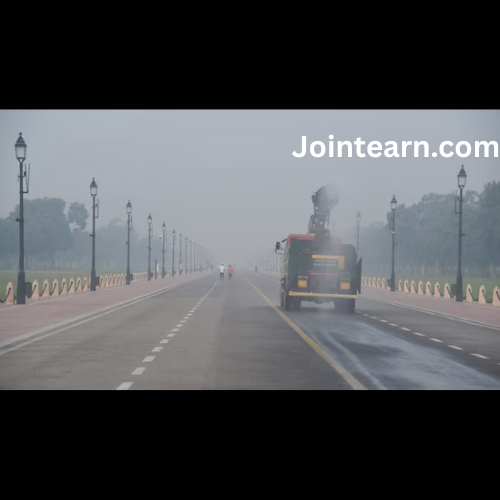
New Delhi | October 24, 2025
As Delhi reels under hazardous levels of air pollution following the Diwali festivities, Chief Minister Rekha Gupta has described cloud seeding as a “necessity” for the national capital. The Chief Minister’s announcement comes at a critical juncture when Delhi’s air quality index (AQI) has plummeted into the ‘severe category,’ with residents gasping under the toxic haze that has enveloped the city. The proposed artificial rain experiment, to be carried out later this month, marks an unprecedented step in India’s fight against urban air pollution and could potentially become a model for other metropolitan cities facing similar environmental crises.
Rekha Gupta, who leads the Delhi government under the Bharatiya Janata Party (BJP), emphasized that the initiative reflects not only the urgency of the situation but also the government’s willingness to explore scientific innovation as a solution. “Cloud seeding is a necessity for Delhi and is the first experiment of its kind. We want to try it in Delhi to see if it can help us control this very serious environmental problem,” she stated while addressing reporters on Friday. Expressing optimism, Gupta added, “The blessings of the people of Delhi are with the government, and we feel that this will be a successful experiment. In the future, we will be able to overcome these environmental problems through such scientific measures.”
The announcement comes just a day after Gupta formally unveiled plans for artificial rain in the national capital, which has been battling an annual post-Diwali air quality crisis for several years. The government has now initiated the first phase of the process, conducting preliminary tests in the Burari area of North Delhi to assess technical feasibility and atmospheric readiness. According to the Chief Minister, if weather conditions remain conducive, Delhi is likely to experience its first-ever artificial rain event on October 29.
A Technological Milestone for Delhi
Cloud seeding, a weather modification technique, involves dispersing specific substances—commonly silver iodide, potassium iodide, or sodium chloride—into clouds to stimulate precipitation. These particles act as condensation nuclei, encouraging water vapor in the atmosphere to form droplets and eventually fall as rain. The process is typically carried out using aircraft equipped with specialized equipment or ground-based generators that release the seeding material into the clouds.
Gupta emphasized that this initiative represents a scientific leap for Delhi’s environmental management system. “According to the weather department, cloudy conditions are expected on October 28, 29, and 30. If the weather remains favourable, Delhi is likely to witness its first artificial rain on October 29,” she posted on social media platform X (formerly Twitter). “This initiative is not only technologically historic but also establishes a scientific approach to combating pollution in Delhi. The government aims to clean the capital’s air and balance its environment through this innovation,” she added.
This artificial rain experiment is being coordinated with experts from the Indian Institute of Technology (IIT) Kanpur, meteorological scientists, and the Indian Meteorological Department (IMD). While such experiments have been attempted in other parts of India, including Maharashtra and Karnataka, this will be the first time Delhi will implement cloud seeding specifically as a pollution-control measure. The Delhi government’s Environment Department and the Delhi Pollution Control Committee (DPCC) have been closely monitoring meteorological patterns to determine the ideal window for the experiment.
The Post-Diwali Pollution Surge
The urgent push for cloud seeding comes in the wake of a dramatic deterioration in Delhi’s air quality following the Diwali festival. Despite repeated advisories and restrictions on firecracker use, large-scale bursting of crackers was reported across Delhi and its adjoining areas, pushing pollution levels to alarming highs. The Central Pollution Control Board (CPCB) recorded the city’s AQI in the ‘severe category,’ a level that poses health risks even to healthy individuals and can have serious respiratory effects on vulnerable populations.
Experts point out that Delhi’s pollution levels have worsened not only because of firecrackers but also due to seasonal and structural factors. As the city transitions into winter, meteorological conditions change—temperatures drop, wind speeds slow, and the air becomes denser, trapping pollutants near the surface. This phenomenon, known as temperature inversion, prevents dispersion of particulate matter, causing smog to persist for days. “The onset of the winter season is accompanied by a rise in air pollution as the air becomes stagnant and pollutants accumulate near the ground,” explained a senior scientist from the IMD.
Data collected over the past month reveals a clear shift in the nature of pollutants dominating Delhi’s air. For the first 19 days of October, photochemical pollutants such as ozone (O₃) and carbon monoxide (CO) were the primary contributors to air pollution. However, starting October 20—the day of Diwali—these gases virtually disappeared from the air quality charts, replaced by fine particulate matter (PM10 and PM2.5). These microscopic particles, largely produced by combustion activities, can penetrate deep into the lungs and enter the bloodstream, causing a range of health problems from respiratory infections to cardiovascular diseases.
Environmental experts have attributed this shift to an increase in combustion-driven emissions. “The data clearly indicates a sharp rise in emissions caused by firecrackers, vehicular traffic, industrial operations, and localized burning,” said one environmental researcher cited by Hindustan Times. “Particulate matter levels have spiked to more than ten times the safe limit in several monitoring stations across the city.”
Public Health and Policy Implications
The deteriorating air quality has sparked widespread public concern. Schools and offices have reported a rise in respiratory illnesses, particularly among children and the elderly. Hospitals across Delhi have noted an uptick in cases of asthma, bronchitis, and eye irritation. The government’s decision to attempt artificial rain reflects an immediate response to mitigate these effects, at least temporarily.
Critics, however, have expressed skepticism about the long-term effectiveness of cloud seeding as a pollution control strategy. Some environmentalists argue that while artificial rain may provide short-term relief by washing away airborne particles, it does not address the root causes of pollution—such as vehicular emissions, industrial discharge, and crop residue burning in neighbouring states. Nevertheless, government officials maintain that the initiative should be viewed as an emergency measure aimed at immediate relief rather than a permanent solution.
A New Approach to an Old Problem
Delhi’s struggle with air pollution is not new. Each year, following Diwali and the onset of winter, the city’s air quality plunges into the hazardous zone. This annual crisis has often been blamed on a combination of factors: crop residue burning in Punjab and Haryana, vehicular congestion, industrial pollution, construction dust, and unfavourable weather conditions. Over the years, multiple governments have introduced various interventions—odd-even traffic schemes, bans on firecrackers, restrictions on construction activities, and the Graded Response Action Plan (GRAP). However, these measures have yielded limited success.
The proposed cloud seeding experiment marks a different approach—an attempt to use atmospheric science as a direct tool for pollution management. “It is an experiment grounded in scientific reasoning and technological innovation,” a Delhi government spokesperson said. “We are not claiming that it will eliminate pollution, but it could significantly reduce pollutant concentration in the short term and help us understand how such methods can be integrated into broader environmental management strategies.”
Looking Ahead
If successful, Delhi’s artificial rain project could open new avenues for tackling pollution in urban centres across India. Cities like Mumbai, Lucknow, and Kolkata have also grappled with poor air quality in recent years and may benefit from similar weather modification techniques. For now, all eyes are on October 29, when Delhi is expected to experience its first-ever artificial rain—weather permitting.
Chief Minister Rekha Gupta concluded her announcement with cautious optimism. “This is a historic moment for Delhi,” she said. “We are combining science, technology, and governance to fight one of the gravest environmental challenges of our time. It is our collective responsibility to ensure that Delhi breathes cleaner air, and this experiment is a step in that direction.”
As Delhi braces for its artificial rainfall experiment, the success or failure of this initiative could shape future environmental policies and set a precedent for innovative approaches to managing urban pollution in India. Whether it will bring the much-needed respite to the residents of the capital remains to be seen, but for now, the city waits—with hope and anticipation—for rain from human hands to cleanse its choked skies.


Leave a Reply